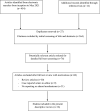A systematic review on shared biological mechanisms of depression and anxiety in comorbidity with psoriasis, atopic dermatitis, and hidradenitis suppurativa
- PMID: 34819201
- PMCID: PMC8668448
- DOI: 10.1192/j.eurpsy.2021.2249
A systematic review on shared biological mechanisms of depression and anxiety in comorbidity with psoriasis, atopic dermatitis, and hidradenitis suppurativa
Abstract
Background: Mental disorders in comorbidity with chronic skin diseases may worsen disease outcome and patients' quality of life. We hypothesized the comorbidity of depression, anxiety syndromes, or symptoms as attributable to biological mechanisms that the combined diseases share.
Methods: We conducted a systematic review based on the Preferred Reporting Items for Systematic Review and Meta-Analysis statement searching into PubMed, PsycInfo, and Scopus databases. We examined the literature regarding the comorbidity of psoriasis (Ps), atopic dermatitis (AD), or hidradenitis suppurativa with depression and/or anxiety in adults ≥18 years and the hypothetical shared underlying biological mechanisms.
Results: Sixteen studies were analyzed, mostly regarding Ps and AD. Brain-derived neurotrophic factor/tropomyosin receptor kinase B signaling and nuclear factor kappa-light-chain-enhancer of activated B cells/p38 mitogen-activated protein kinase pathways arose as shared mechanisms in Ps animal models with depression- and/or anxiety-like behaviors. Activated microglia and neuroinflammatory responses emerged in AD depressive models. As to genetic studies, atopic-dermatitis patients with comorbid anxiety traits carried the short variant of serotonin transporter and a polymorphism of the human translocator protein gene. A GA genotype of catechol-O-methyltransferase gene was instead associated with Ps. Reduced natural killer cell activity, IL-4, serotonin serum levels, and increased plasma cortisol and IgE levels were hypothesized in comorbid depressive AD patients. In Ps patients with comorbid depression, high serum concentrations of IL-6 and IL-18, as well as IL-17A, were presumed to act as shared inflammatory mechanisms.
Conclusions: Further studies should investigate mental disorders and chronic skin diseases concurrently across patients' life course and identify their temporal relation and biological correlates. Future research should also identify biological characteristics of individuals at high risk of the comorbid disorders and associated complications.
Keywords: Anxiety; chronic inflammatory skin diseases; depression; shared biologic mechanisms.
Figures
References
Publication types
MeSH terms
Substances
LinkOut - more resources
Full Text Sources
Medical
Research Materials
Miscellaneous


